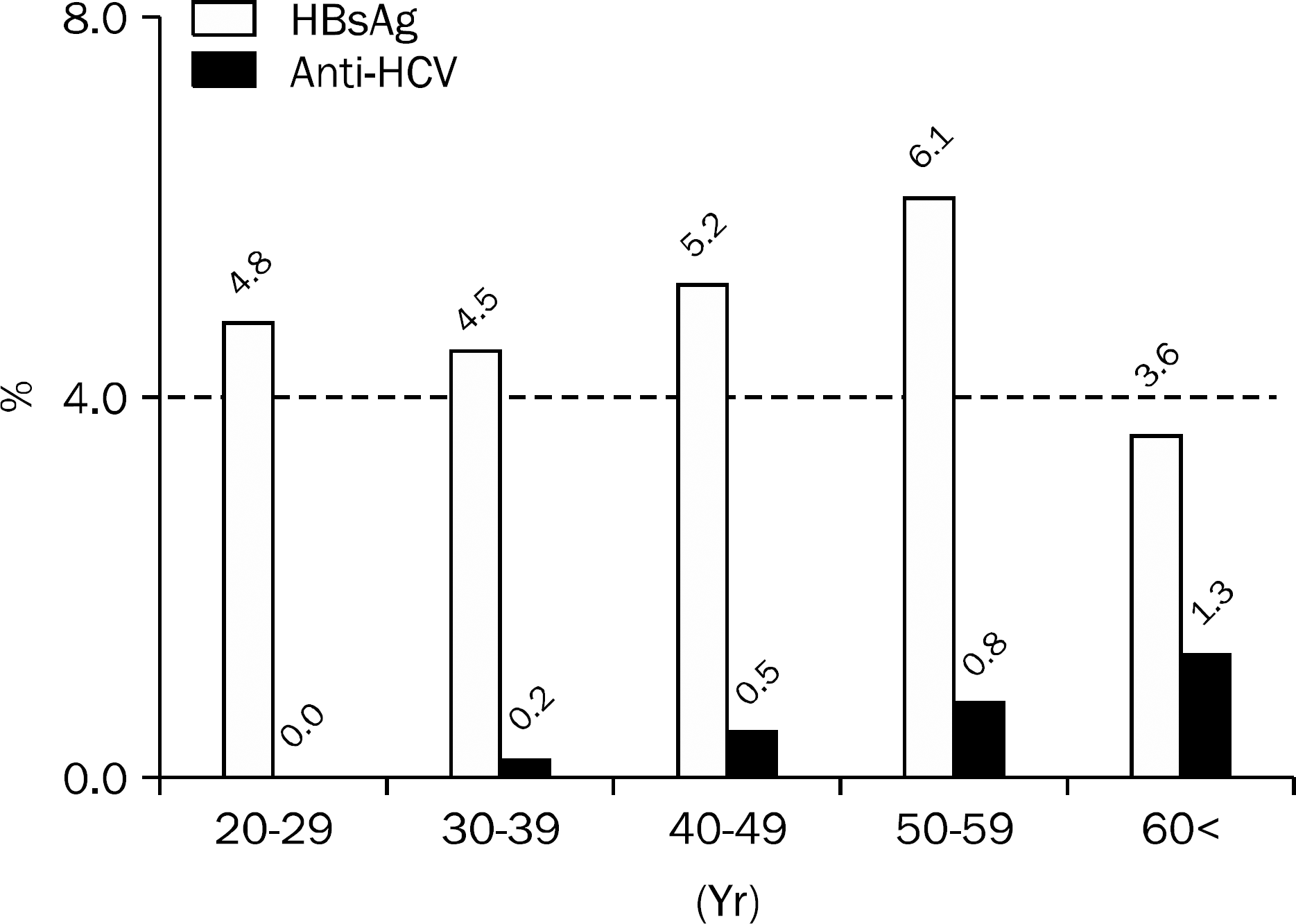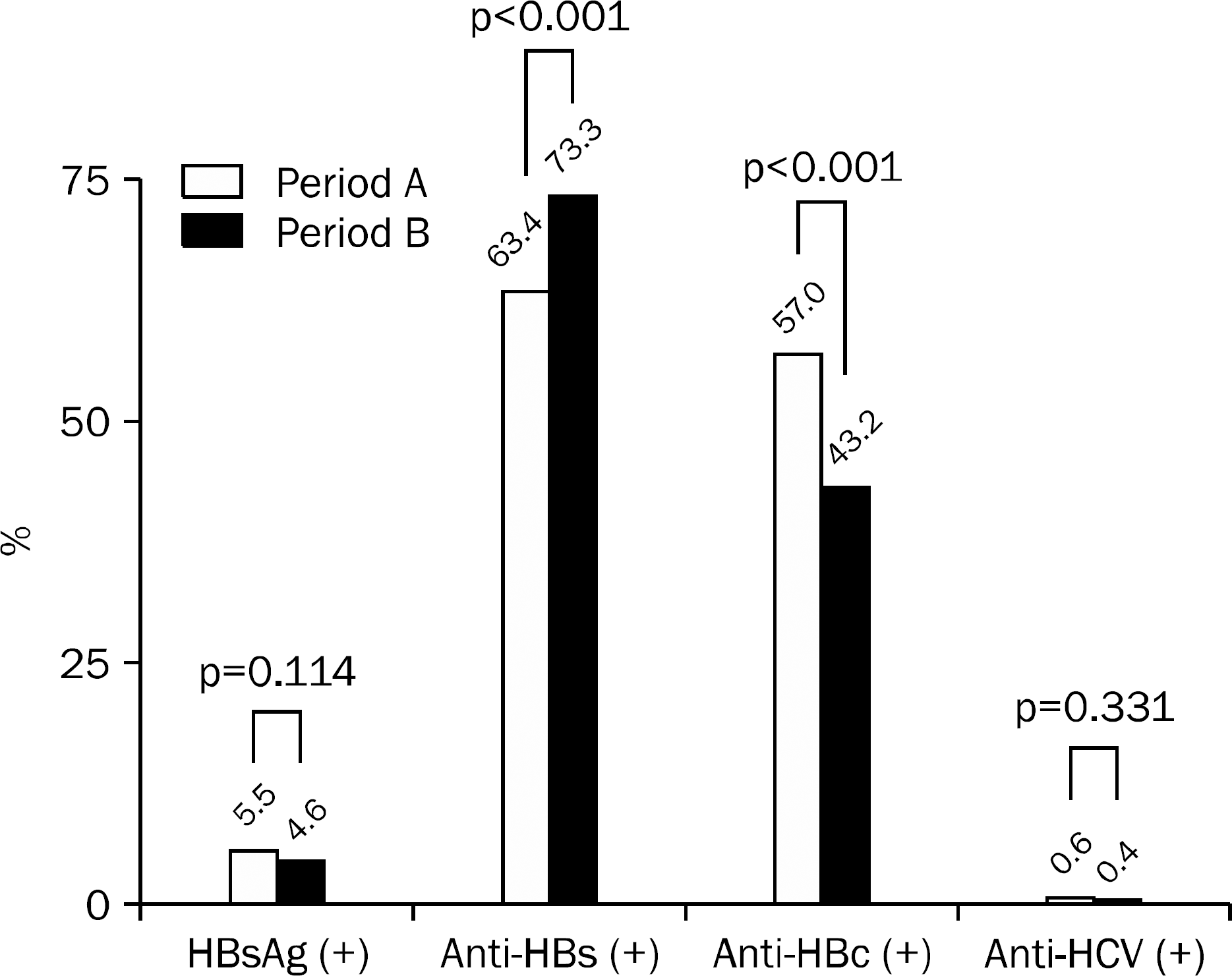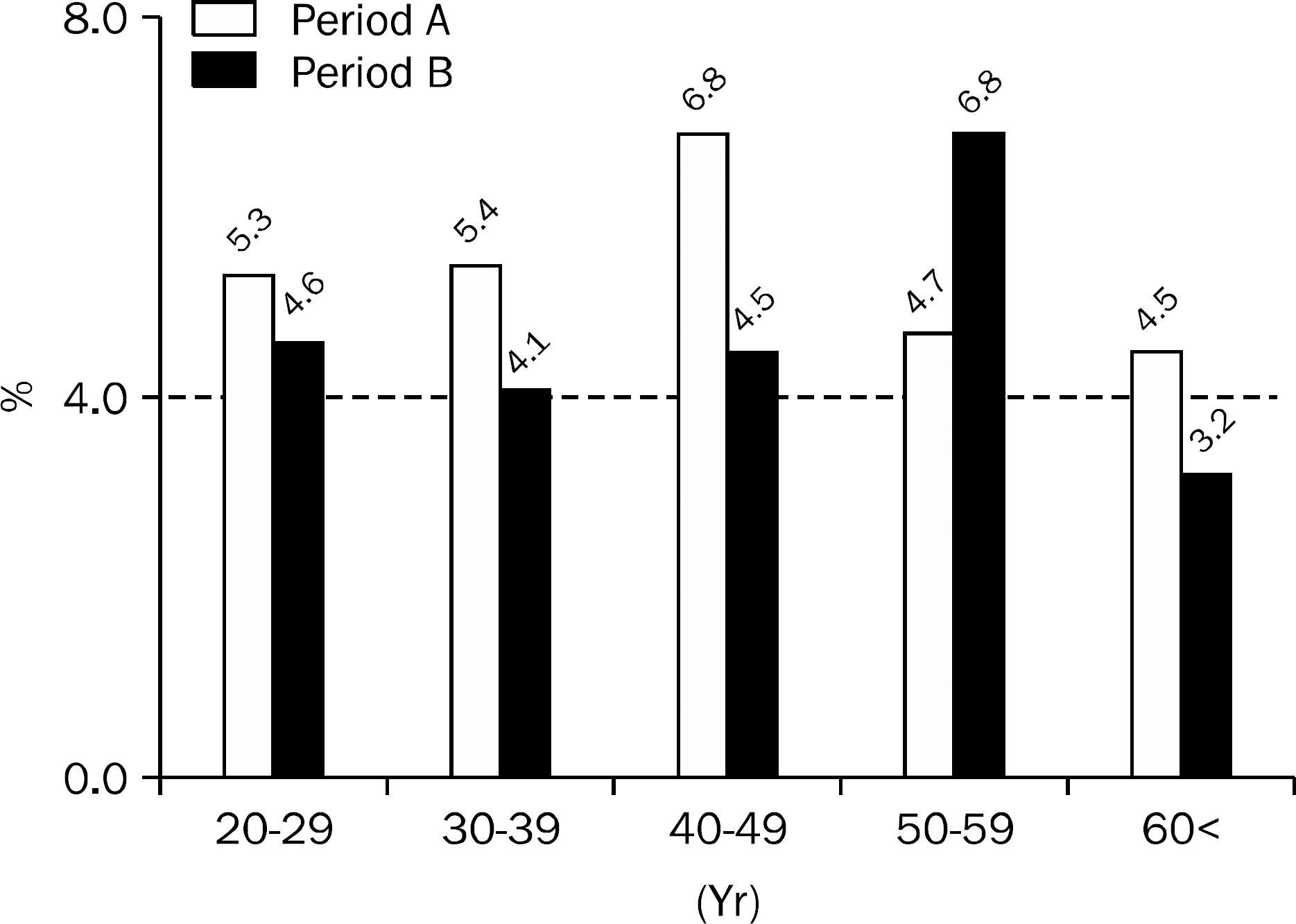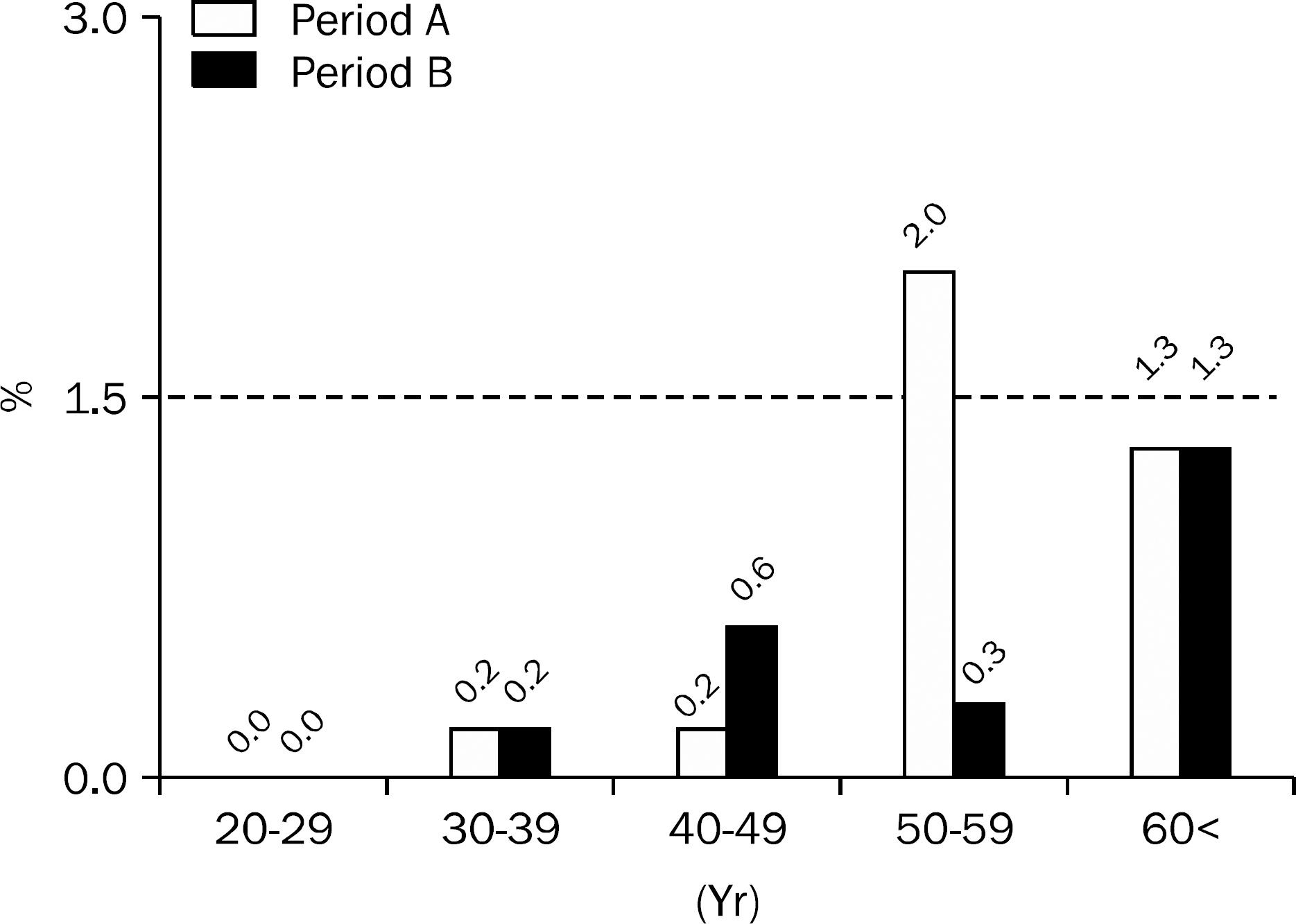Abstract
Background/Aims
There have been only few studies on the population-adjusted seroprevalence of HBV and HCV and on the change of them for more than 10 years in Korea. Therefore, this study was performed to evaluate them at a single health center in Daegu and Gyeongbuk province considering the population composition ratio.
Methods
We analyzed the seromarkers of HBV and HCV of 6,237 randomly sampled adults who had received health screening at the health promotion center in Dongsan hospital during the periods from year 1997 to 1999 (Period A) and from 2007 to 2009 (Period B).
Results
The seroprevalences of HBsAg, anti-HBs, anti-HBc and anti-HCV were 4.8%, 70.2%, 47.4%, and 0.5%, respectively. There is no difference in the seroprevalence of HBsAg between period A and B. However, downward tendency of prevalence through A to B from 6.8% to 4.5% could be found in 40s, and upward tendency from 4.7% to 6.8% in 50s. As for the seroprevalence of anti-HCV, although there was no difference through A to B, for 50s, it decreasd from 2.0% to 0.3% (p=0.007). However, for 60s, it increased as much as decreasd for 50s.
Go to : 
References
2. Kim YS, Um SH, Ryu HS, et al. The prognosis of liver cirrhosis in recent years in Korea. J Korean Med Sci. 2003; 18:833–841.

3. Lee HS, Han CJ, Kim CY. Predominant etiologic association of hepatitis C virus with hepatocellular carcinoma compared with hepatitis B virus in elderly patients in a hepatitis B-endemic area. Cancer. 1993; 72:2564–2567.

4. Wasley A, Kruszon-Moran D, Kuhnert W, et al. The prevalence of hepatitis B virus infection in the United States in the era of vaccination. J Infect Dis. 2010; 202:192–201.

5. Chae HB, Kim JH, Kim JK, Yim HJ. Current status of liver diseases in Korea: hepatitis B. Korean J Hepatol. 2009; 15(Suppl 6):S13–S24.

6. Choe BH. The epidemiology and present status of chronic hepatitis B in Korean children. Korean J Pediatr. 2008; 51:696–703.

7. Kim SB, Lee WK, Choi H, et al. A study on viral hepatitis markers and abnormal liver function test in adults living in northwest area of Chungnam. Korean J Gastroenterol. 2009; 53:355–360.

8. Park KS, Lee YS, Lee SG, et al. A study on markers of viral hepatitis in adults living in Daegu and Gyungbuk area. Korean J Gastroenterol. 2003; 41:473–479.
9. Joo KR, Bang SJ, Song BC, et al. Hepatitis B viral markers of Korean adults in the late 1990s : survey data of 70,347 health screenees. Korean J Gastroenterol. 1999; 33:642–652.
10. Lim YS. Current status of liver disease in Korea: hepatitis C. Korean J Hepatol. 2009; 15(Suppl 6):S25–S28.

11. Shin HR, Kim JY, Song JB, et al. Seroepidemiologic study of hepatitis B virus(HBV) and hepatitis C virus(HCV) infection among Koreans in rural area, Korea. Korean J Prev Med. 1997; 30:17–30.
12. Jang KM, Woo SH, Yun DH, et al. Seroepidemiologic survey on type B viral hepatitis in Incheon area. Korean J Med. 1983; 26:1331–1336.
13. Jeong S, Yim HW, Bae SH, Lee WC. Changes of hepatitis B surface antigen seroprevalence in Korea, 1998–2005. Korean J Epidemiol. 2008; 30:119–127.

14. Jun GH, Kim JJ, Shin DH, Yoon SD. A survey of HBs antigenemia among healthy primary and middle children, pregnant women in Kyungpook Province. J Korean Pediatr Soc. 1983; 26:1188–1195.
15. Seo JH. Hepatitis B surface antigen and antibody positive rates of children and adolescents in Jeju. Korean J Hepatol. 2003; 9:304–314.
16. Lee DH, Kim JH, Nam JJ, Kim HR, Shin HR. Epidemiological findings of hepatitis B infection based on 1998 National Health and Nutrition Survey in Korea. J Korean Med Sci. 2002; 17:457–462.

17. Esteban JI, Sauleda S, Quer J. The changing epidemiology of hepatitis C virus infection in Europe. J Hepatol. 2008; 48:148–162.

18. Shin HR, Hwang SY, Nam CM. The prevalence of hepatitis C virus infection in Korea: pooled analysis. J Korean Med Sci. 2005; 20:985–988.

Go to : 
 | Fig. 1.Seropositivities of HBsAg and anti-HCV according to age groups. Seropositivity of HBsAg was highest in 50s and that of anti-HCV was increasing with age. |
 | Fig. 2.Seropositivities of HBsAg, anti-HBs, anti-HBc, and anti-HCV according to examined time periods. Although the seropositivity of HBsAg was decreasing, there was no statistical significance. The seropositivity of anti-HBs was increasing in contrast to anti-HBc which was decreasing.
Period A, year 1998 to 2000; Period B, year 2007 to 2009.
|
 | Fig. 3.Seropositivity of HBsAg according to both examined time periods and age groups. There was no significant difference of the value between two time periods. However, main portion of HBsAg-positive population seems shifting to 50s from 40s.
Period A, year 1998 to 2000; Period B, year 2007 to 2009.
|
 | Fig. 4.Seropositivity of anti-HCV according to both examined time periods and age groups. In the 50s, the seropositivity of anti-HCV at period A was significantly higher than period B (p=0.007).
Period A, year 1998 to 2000; Period B, year 2007 to 2009.
|
Table 1.
Age and Gender Distribution of Study Population




 PDF
PDF ePub
ePub Citation
Citation Print
Print


 XML Download
XML Download